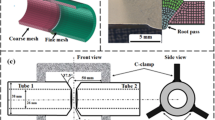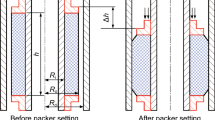Abstract
The mechanical behaviour of the materials used as compressible gasket in the ultra high pressure apparatus is investigated. Materials such as pyrophyllite and talc, showing a pressure sensitive plastic flow behaviour were considered and a testing configuration was set up for studying the dependence of their plastic response on the hydrostatic component of the stress tensor, according to the Drucker-Prager criterion. A Finite Element modelling of the test was performed to evaluate the specimen response and the local stress condition, during loading. The Finite Element results were validated by comparison with those of a specific experimental characterisation. A parametric analysis was then carried out, by varying the materials constitutive behaviour, in order to build up a data base of representative curves. In this way an algorithm was developed, with the aim of determining the material constitutive behaviours by the analysis of the experimental data. The proposed procedure was then used to study the mechanical response of different gasket materials.
Similar content being viewed by others
References
Bundy FP (1988) Ultra-high pressure apparatus. Physics reports (Review section of Physics letters) 167(3):135–176.
Chien-Min Sung (1997) A century of progress in the development of very high pressure apparatus for scientific research and diamond synthesis. High Temp, High Press 29(3):253–294.
Wang Qiang, Fang Hc, Wei Lu, Dejun Li, Wang ZR (1995) Strength analysis and optimization for both the cylinder and the anvil of a belt-type ultra-high pressure apparatus by FEM. J Mater Process Technol 55:5–10.
Venkateswaran C, Anbukumaran K, Victor Jaya N, Natarajan S (1997) Design and performance of a belt-type high pressure, high temperature apparatus. Rev Sci Instrum 68(1):189–192 (January).
Fukunaga O, Yamaoka S, Endoh T, Akaishi M, Kanda K (1979) Modification of belt-like high-pressure apparatus. In: Timmerhaus KD, Barber Plenum MS (eds) High Pressure Science. New York, pp 846–851.
Schroeder W, Webster DA (1949) Press-forging thin sections: effect of friction, area and thickness on pressure required. J Appl Mech 16:289–294.
Wakatsuki M, Ichinose K, Aoki T (1972) Notes on Compressible gasket and Bridgman-anvil type high pressure apparatus. Jap J of Applied Physics 11(4):578–589 (April).
Dunstan DJ (1989) Theory of the gasket in diamond anvil high pressure cells. Rev Sci Instrum 60(12):3789–3795 (December).
King JH (1965) Choice of materials for use in compressible-gasket high pressure apparatus. J Sci Instrum 42:374–380.
Katrusiak A (1999) Facilitating preparation of gaskets for routine high-pressure diffraction studies. J Appl Cryst 32:1021–1023.
Okai B, Yoshimoto J (1973) Large Bridgman anvils and mechanical properties of pyrophyllite. High Temp, High Press 5:675–678.
Okai B,Yoshimoto J (1971) Shear strength of pyrophyllite up to 80 kbar. Japan J Appl Phys 4:534–535.
Walker D (1991) Lubrication, gasketting and precision in multianvil experiments. Am Mineral 76:1092–1100.
Yoneda A, Yamamoto S, Kato M, Sawamoto H (1984) The use of composite metal gasket to improve pressure generation in multiple anvil devices. High Temp, High Press 16:637–656.
Hicks Tara L, Secco RA (1997) Dehydration and decomposition of pyrophyllite at high pressures: electrical conductivity and X-ray diffraction studies to 5 GPa. Can J Earth Sci 34(6):875.
Hennicke HW, Schwiete HE, Kremer D (1964) Keramische Untersuchungen an naturlich kompakten pyrophyllite (Wonderstone). Berichte der Deutschen Keramischen Gesellschaft 41(9):473–477.
ThaoZhi Chi, Pu Zheng Xing (1977) Types and phase transitions of the chaochiatai pyrophyllite with special reference to their influence on diamond synthesis. Scientia Sinica 20(1):75–88.
Bentayeb A, Masson O, Nadiri A (2000) A mineralogical study of a natural llite. Powder Diffr 15(1):51–56.
Giese RF, Costanzo PM, van Oss CJ (1991) The surface free energies of talc and pyrophyllite. Phys Chem Miner 17(7):611–618.
Zienkiewicz OC, Chan AH, Pastor M, Schrefler BA, Shiomi T (1999) Computational geomechanics. John-Wiley & Sons, West Sussex, UK.
Doltsinis I (2000) Elements of plasticity—Theory and computation. WIT Press, Southampton UK.
Lubliner J (1990) Plasticity theory. Macmilla Pub. Comp. New York USA.
Wang L, Zhang Z (1997) High temperature phases of pyrophyllite and their evolutionary characteristic. Chin Sci Bull 42(2).
Sanchez-Soto PJ, Perez-Rodriguez JL (1997) SEM study of pyrophyllite high temperature transformations. J Mater Sci 42(2).
Author information
Authors and Affiliations
Corresponding author
Rights and permissions
About this article
Cite this article
Fontanari, V., Bellin, F., Visintainer, M. et al. Study of Pressure Sensitive Plastic Flow Behaviour of Gasket Materials. Exp Mech 46, 313–323 (2006). https://doi.org/10.1007/s11340-006-7105-1
Received:
Accepted:
Published:
Issue Date:
DOI: https://doi.org/10.1007/s11340-006-7105-1




